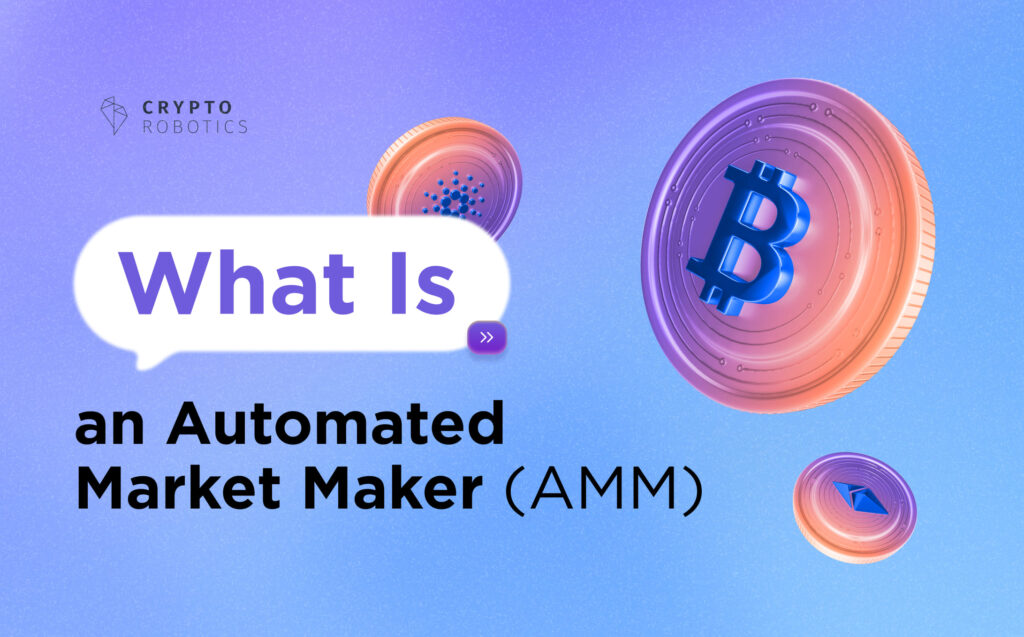What are Automated Market Makers (AMM)?

Automated Market Makers (AMM) are a type of decentralized exchange (DEX) that uses mathematical algorithms to create liquidity and determine the price of assets. In traditional exchanges, market makers are usually employed for this purpose, offering to buy or sell assets to ensure liquidity and market stability.
A key feature of AMMs is the absence of an order book. Instead, the price of an asset and its availability are determined by an algorithm based on the state of the reserves (liquidity pools) for each trading pair. This allows for round-the-clock operations, without the need for a market maker for each specific transaction.
One of the most well-known examples of an AMM is Uniswap on the Ethereum platform. In Uniswap, each trading pair has its own liquidity pool, containing two assets (e.g., ETH and DAI). Any user can deposit these assets into the pool and become a liquidity provider. In return, they receive a share of the transaction fees generated through that pool.
AMMs have their own advantages and disadvantages. On the one hand, they offer high availability and decentralization. On the other hand, they can be subject to various forms of manipulation and attacks, such as “impermanent loss,” and may offer less favorable rates for large transactions compared to traditional exchanges.
How Does an Automated Market Maker (AMM) Work?
Automated Market Makers (AMM) are usually based on smart contracts and operate on blockchain platforms such as Ethereum, Binance Smart Chain, and others. Let’s look at the core principles of AMM operation:
Liquidity Pools
The central element in an AMM is the liquidity pool. This is a smart contract that holds two or more tradable assets. Any user can become a liquidity provider by adding a certain amount of assets to the pool.
Liquidity Tokens
Liquidity providers often receive special tokens (LP tokens) that confirm their share in the pool. These tokens can be used to withdraw the corresponding share of assets from the pool, as well as to earn a portion of transaction fees.
Pricing Algorithms
The price of assets in an AMM is algorithmically determined. One of the most simple and popular methods is the x * y = k formula, where x and y are the amounts of each asset in the pool, and k is a constant. The asset price automatically changes upon buying or selling, depending on the size of the pool and the volume of the transaction.
Trading
To execute trading operations, users send transactions to the pool’s smart contract. They can buy or sell assets, and the pool automatically updates its reserves and the asset’s price in accordance with the chosen pricing algorithm.
Fees
A small fee is usually charged for each trading operation, which is distributed among the liquidity providers. This encourages users to provide liquidity to the pool.
Impermanent Loss
One of the risks for liquidity providers is the so-called “impermanent loss.” This refers to losses that may occur due to the changing ratio of assets in the pool, especially if the price of one of the assets fluctuates significantly.
AMMs represent a unique and innovative mechanism that enables decentralized asset trading. However, it’s important to understand and consider all the risks and limitations of this technology.
The Role of Liquidity Pools and Liquidity Providers in AMM
In Automated Market Makers (AMM), liquidity pools and liquidity providers play a crucial role. Let’s delve into what these are and what their function is.
Liquidity Pools
Liquidity pools are reserves of assets that are stored in smart contracts on blockchain platforms. They serve as the basis for trading in an AMM. Typically, a pool contains two assets (for example, ETH and USDC), and their ratio to each other determines the current market price for that trading pair.
Role of Liquidity Pools
- Providing Liquidity: Pools allow users to execute trading operations without the need for an intermediary. Anyone can buy or sell assets by directly interacting with the pool.
- Price Determination: Algorithms in the smart contracts automatically set the price of assets based on the current state of the pool.
- Availability: Pools operate 24/7, providing the ability to trade assets without delays or restrictions.
Liquidity Providers
Liquidity providers are users who contribute assets to liquidity pools. They do this in exchange for liquidity tokens, which confirm their share in the pool.
Role of Liquidity Providers
- Market Maintenance: Liquidity providers furnish the resources necessary for the AMM to function.
- Earning Revenue: As a reward for contributing their assets, liquidity providers usually receive a portion of the trading fees that pass through the pool.
- Risk Management: Liquidity providers need to consider risks such as “impermanent loss,” asset price fluctuations, and other factors that could impact their investment.
In summary, liquidity pools and liquidity providers collectively create an ecosystem that enables AMMs to function efficiently. Liquidity providers supply the necessary resources for liquidity, and liquidity pools serve as a mechanism for automatic price determination and execution of trading operations.
Yield farming in the context of Automated Market Makers (AMM)
Yield Farming — a practice of using capital to earn income or rewards in the form of additional cryptocurrency tokens — has become especially popular in the decentralized finance (DeFi) ecosystem, including Automated Market Makers (AMM). Here’s how it typically works within the AMM framework:
- Supplying Liquidity: The first step involves becoming a liquidity provider in one or more liquidity pools on an AMM platform. To do this, you need to deposit a certain amount of two tokens (e.g., ETH and USDC) into the corresponding pool.
- Receiving LP Tokens: After depositing liquidity, users receive special tokens (LP tokens) that confirm their share in the liquidity pool.
- Earning from Liquidity Provision: Some AMM platforms offer additional programs to incentivize liquidity provision. In these programs, LP tokens can be staked into special smart contracts to farm additional tokens.
- Collecting Rewards: After a certain time period or upon meeting specific conditions, farmers can collect their rewards.
Types of Earnings
- Commissions: Liquidity providers receive a portion of trading fees from the trades conducted through the pool in which they participate.
- Token Farming: Additional farming rewards, usually in the form of the platform’s governance tokens (e.g., UNI for Uniswap or CAKE for PancakeSwap).
- Compound Interest: Some yield farming strategies may automatically reinvest the earned rewards to increase future earnings.
Risks
- Impermanent Loss: Changes in the price ratio of tokens in the pool can lead to losses for liquidity providers.
- Smart Contract Risk: If there are vulnerabilities in the smart contract, it could lead to a loss of funds.
- Regulatory Risk: Like the entire DeFi sector, yield farming could be subject to regulatory constraints.
- Market Risks: The volatility of the assets can significantly affect profitability.
It’s important to carefully study all aspects and risks of yield farming before investing. It’s best to first conduct a detailed analysis or consult with an expert in this field.
What are the models of Automated Market Makers (AMM)?
Models of Automated Market Makers (AMM) differ in how they handle asset pricing and liquidity. Below are some of these models:
Constant Product Market Maker (CPMM)
This model is one of the most popular and is frequently used by platforms such as Uniswap. In this model, the formula x · y = k is used to determine the price of the assets. Here, x and y represent the quantities of two different assets in the pool, and k is a constant. This model is simple and intuitive but can lead to significant “impermanent losses” for liquidity providers during large price fluctuations.
Constant Sum Market Maker (CSMM)
This model is less commonly encountered in practice. In it, the price of assets is determined so that the sum of the quantities of the two assets in the pool remains constant. This model may be useful in some specific scenarios but is not as effective in providing liquidity as the constant product model.
Constant Mean Market Maker (CMMM)
This model is rarely used and is more complex from a mathematical standpoint. It aims to minimize “impermanent losses” for liquidity providers by automatically adapting to changes in the price ratio of the assets. However, due to its complexity, it still needs to be carefully studied and tested in practice.
Other Models
- Balancer: This type of AMM allows for the creation of pools with multiple tokens of varying weights, making it flexible and adaptive.
- Curve Finance: This is a specialized AMM for stablecoins. It minimizes impermanent losses and provides favorable exchange conditions for assets with similar prices.
- SushiSwap: A variation on the Uniswap model, but with additional features such as token staking and governance.
Each model has its pros and cons, including varying levels of impermanent loss risk, capital efficiency, and price stability. Therefore, the choice of model depends on specific trading and investment requirements.
Conclusion
Automated Market Makers (AMMs) have a significant impact on the decentralized finance (DeFi) ecosystem. They provide 24/7 liquidity and offer additional income streams through yield farming.
Various AMM models have their strengths and weaknesses, and as this sector grows, so does the number of potential risks. These risks include factors such as impermanent losses and vulnerabilities in smart contracts.
Potential participants should carefully study different models and platforms, possibly consulting with experts. With a prudent approach, AMMs can become a valuable tool for diversifying one’s portfolio and increasing returns.


